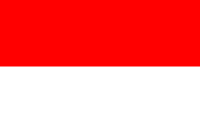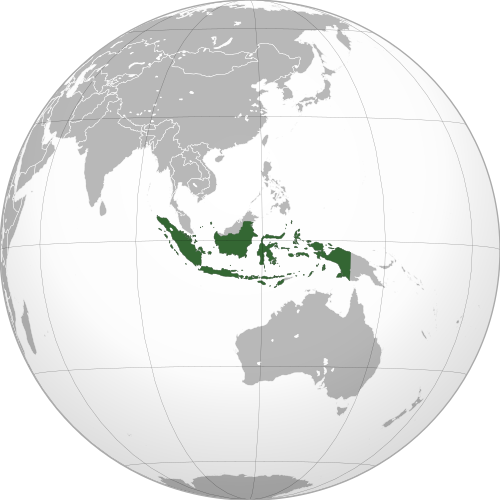 Indonesia (pronounced /ˌɪndoʊˈniːziə/ or /ˌɪndəˈniːʒə/), officially the Republic of Indonesia (Indonesian:Republik Indonesia), is a country in Southeast Asia and Oceania. Indonesia comprises 17,508 islands. With a population of around 230 million people, it is the world’s fourth most populous country, and has the world’s largest population of Muslims. Indonesia is a republic, with an elected legislature and president. The nation’s capital city is Jakarta. The country shares land borders with Papua New Guinea, East Timor, and Malaysia. Other neighboring countries include Singapore, Philippines, Australia, and the Indian territory of the Andaman and Nicobar Islands. Indonesia is a founding member of ASEAN and a member of the G-20 major economies.
Indonesia (pronounced /ˌɪndoʊˈniːziə/ or /ˌɪndəˈniːʒə/), officially the Republic of Indonesia (Indonesian:Republik Indonesia), is a country in Southeast Asia and Oceania. Indonesia comprises 17,508 islands. With a population of around 230 million people, it is the world’s fourth most populous country, and has the world’s largest population of Muslims. Indonesia is a republic, with an elected legislature and president. The nation’s capital city is Jakarta. The country shares land borders with Papua New Guinea, East Timor, and Malaysia. Other neighboring countries include Singapore, Philippines, Australia, and the Indian territory of the Andaman and Nicobar Islands. Indonesia is a founding member of ASEAN and a member of the G-20 major economies.
The Indonesian archipelago has been an important trade region since at least the seventh century, when Srivijaya and then later Majapahit traded with China and India. Local rulers gradually absorbed foreign cultural, religious and political models from the early centuries CE, and Hindu and Buddhist kingdoms flourished. Indonesian history has been influenced by foreign powers drawn to its natural resources. Muslim traders broughtIslam, and European powers fought one another to monopolize trade in the Spice Islands of Maluku during the Age of Discovery. Following three and a half centuries of Dutch colonialism, Indonesia secured its independenceafter World War II. Indonesia’s history has since been turbulent, with challenges posed by natural disasters, corruption, separatism, a democratization process, and periods of rapid economic change. The current nation of Indonesia is a unitary presidential republic consisting of thirty three provinces.
Across its many islands, Indonesia consists of distinct ethnic, linguistic, and religious groups. The Javaneseare the largest—and the politically dominant—ethnic group. Indonesia has developed a shared identity defined by a national language, ethnic diversity, religious pluralism within a majority Muslim population, and a history of colonialism including rebellion against it. Indonesia’s national motto, “Bhinneka Tunggal Ika” (“Unity in Diversity”literally, “many, yet one”), articulates the diversity that shapes the country. Despite its large population and densely populated regions, Indonesia has vast areas of wilderness that support the world’s second highest level of biodiversity. The country is richly endowed with natural resources, yet poverty remains widespread in contemporary Indonesia.
Indonesia has around 300 ethnic groups, each with cultural identities developed over centuries, and influenced by Indian, Arabic, Chinese, Malay, and European sources. Traditional Javanese and Balinese dances, for example, contain aspects of Hindu culture and mythology, as do wayang kulit (shadow puppet) performances. Textiles such as batik, ikat and songket are created across Indonesia in styles that vary by region. The most dominant influences on Indonesian architecture have traditionally been Indian; however, Chinese, Arab, and European architectural influences have been significant.
Crude oil and natural gas are Indonesia’s most valuable natural resources and were long its major source of export revenue, but production has declined and domestic use increased since the 1990s. Agriculture accounts for about 13% of the GDP and employs over 40% of the labor force. Indonesia is one of the world’s major rubber producers; other plantation crops include cocoa, coffee, palm oil, coconuts, sugarcane, tea, tobacco, cinchona, cloves, sisal, and spices. Despite plantation cultivation, Indonesia has a wide landholding base; the majority of the people are largely self-sufficient in food. Rice is the major crop; cassava, corn, yams, soybeans, peanuts, and fruit are also grown. Horses and cattle are raised on some of the Lesser Sunda Islands. Fish are abundant, both in the ocean and in inland ponds.
In natural-resource potential, Indonesia is one of the wealthiest countries in the world. It has great timberlands; vast rain forests of giant trees (among the world’s tallest) cover the mountain slopes, and teak, sandalwood, ironwood, camphor, and ebony are cut. Palm, rattan, and bamboo abound, and a great variety of forest products is produced. Indonesia is a major exporter of timber, accounting for nearly half of the world’s tropical hardwood trade, but the rapid deforestation of Indonesia’s hardwoods, mainly due to its expanding population and growing timber-related industries, has caused concern among international environmental groups and sparked ethnic conflict (particularly between immigrants and native Dyaks on Borneo). In addition, enormous out-of-control brush fires, started illegally during the dry season to clear land, have caused significant health, navigation, and economic hazards in some years.
Notes from Wikipedia and Answers.com









